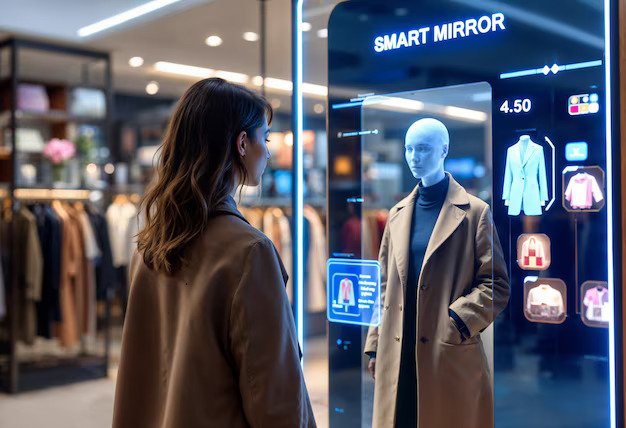
Part 1: AR/VR in Retail: Creating immersive customer experiences
Evolution is inevitable, and with each passing month or year, the technology industry continues to transform, reaching new heights of innovation. The adoption of cutting-edge technologies has revolutionized the way people live, simplifying daily tasks and elevating overall standards of living. Among these advancements, Augmented Reality [AR] and Virtual Reality [VR] are transforming the retail industry and are redefining shopping standards, delivering hyper-personalized experiences that captivate customers.
With renowned brands like Ikea, Valentino, Nike, and Sephora among the early adopters, integrating AR/VR into their customer experiences. With this, the immersive shopping landscape is booming. According to Statista Market Insights, the AR/VR market in retail is projected to reach a staggering USD 62.0 billion by 2029.
AR/VR in Retail:
Sephora: Bridging the online and In-store gapSephora’s Augmented Reality Mirror seamlessly connects in-store and online shopping experiences. Leveraging advanced facial recognition technology, the tool allows users to virtually try on different shades of makeup products, ensuring higher satisfaction with online purchases. This innovation enables customers worldwide to explore and experiment with Sephora's products without visiting a physical store.
IKEA: Redefining furniture shopping
IKEA’AR application has been a game changer, eliminating the need for customers to travel 3-4 hours to a physical store. Using advanced 3-D rendering, this app allows customers to visualize furniture in their own spaces. From selecting the perfect product to choosing complimentary colors, IKEA’s AR app—the first to use Apple ARKit’s technology—empowers customers to design their ideal home environment effortlessly.
Valentino- A Virtual Luxury Experience
Luxury fashion brand Valentino became the first to collaborate with WANNA for a virtual try-on experience. This AR tool enables customers to experiment with designer bags in various styles and colors, pairing them with different outfits to assess the fit and look—anytime, anywhere. By combining innovation with elegance, Valentino sets new standards for luxury shopping.
Nike: Experiential Retail for Gen Z
Nike, a global sportswear giant with 67% of its customer base comprising Gen Z, is leveraging AR to enhance experiential retail. The Nike Fit Feature uses AR to measure customer’s feet and recommend the perfect shoe size, offering a seamless and personalized shopping experience. This technology not only saves time but also builds customer confidence in online purchases.
AR/VR in Retail: Indian Retail Brands
Nykaa: Enhancing Beauty Shopping
Another brand making it possible for enthusiast shoppers to virtually try on products using AR/VR. Powered by Modiface , Nykaa- an India e-commerce company allows users to try on a host of L’Oreal products, allowing them to experiment with multiple shades, ensuring a personal and satisfying shopping experience.
Lenskart: Transforming Eyewear shopping experiences
Lenskart, India’s leading eyewear retailer, is making shopping for eyeglasses and sunglasses effortless with its AR-enabled mobile application. The AR tool scans and analyzes the user’s face, recommending the most suitable frames that can be further filtered based on the individual's preferences. This seamless technology enables customers to explore eyewear from top Indian and luxury brands, all from the comfort of their homes.
Westside: Immersive In-Store Experiences
Westside, part of Tata Group’s Trent Ltd., is one of India’s largest and fastest-growing chains of retail stores. To create an immersive shopping experience, Westside has installed VR pods in its store for a 360-degree view of products before purchasing them. Allowing customers to view the product from all angles has increased customer engagement and improved overall satisfaction.
Tanishq: Virtual Jewelry Try-On
Tanishq, the iconic Indian jewelry brand under Titan Company, has embraced AR technology to transform the jewelry shopping experience. Leveraging Vossle’s advanced face detection feature, customers can virtually try on pieces from Tanishq’s bridal Polki collection. This instant virtual try-on solution enables users to explore designs effortlessly, making jewelry shopping more interactive and enjoyable.
India’s AR/VR Market Expansion Potential:
While the United States currently leads in revenue generation, India’s AR/VR market is rapidly gaining traction. By 2029, the number of AR/VR users in India is projected to reach 770.3 million, driven by advancements in digital education and immersive entertainment technologies.
Key Trends include:
India’s smartphone penetration, which was 54% in 2020, is anticipated to reach 96% by 2040, enhancing accessibility to AR/VR-based technologies. With a projected CAGR of 38% by 2027, India’s AR/VR market is poised for robust growth, setting the stage for future trends in retail and beyond.
The future of Indian retail is augmented, immersive and intelligent. Businesses that embrace AR/VR technologies will not only lead the industry but also set new benchmarks for customer engagement. With significant strides already made, Indian retail brands are paving the way for a future where technology and shopping seamlessly converge.
Impact of AR/VR in Retail:
Challenges of AR/VR Implementation:
Conclusion:
AR/VR technology is undoubtedly transforming the retail landscape by delivering immersive, engaging, and efficient shopping experiences. From enhancing customer confidence to increasing sales and optimizing store operations, its benefits are substantial. However, challenges such as cost, hardware limitations, and the absence of personalized support must be addressed for widespread adoption.
As the AR/VR market continues to expand, retailers must embrace this innovation to remain competitive and meet evolving customer expectations. The future of shopping is here—and it is immersive, interactive, and powered by AR/VR.